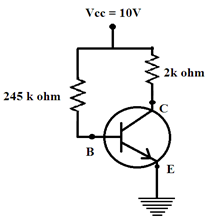
In a common emitter transistor circuit the base current is \[40\mu {\text{A}}\], then \[{V_{BE}}\] is:

A) $2V$
B) $0.2V$
C) $0.8V$
D) $Zero$
Answer
217.5k+ views
Hint: By using current formula $V = IR$, the current flowing through a voltage V and resistance R. show the figure in common emitter transistor circuit, and given values are base current is \[40\mu {\text{A}}\], voltage current is \[{V_{CC}} = 10V\]and the base resistance is $245K\Omega $. Find the base emitter voltage\[{V_{BE}}\].
Complete step by step answer:
The given values are,
Base current is\[40\mu {\text{A}}\]
Voltage current\[{I_V} = {V_{CC}} = 10V\]
Base resistance ${R_B} = 245K\Omega $
We know,
Input voltage ${I_V} = {V_{BE}} + ({I_B}) \times ({R_B})$
Where,
${I_B}$ Is the base current, and
${R_B}$ Is the resistance offered in the base region.
${V_{BE}} = {I_V} - {I_B} \times {R_B}$
\[{I_V} = {V_{CC}} = 10V\] And
${I_B} = 40\mu A$
$ \Rightarrow 40 \times {10^{ - 6}}A$
Also,${R_B} = 245K\Omega $
$ \Rightarrow 245 \times {10^3}\Omega $ [From the figure]
Putting their respective values, we get:
${V_{BE}} = 10 - (40 \times {10^{ - 6}}A)(245 \times {10^3}\Omega )$
On simplification the bracket term and we get
$ \Rightarrow (10 - 9.8)V$
On subtracting we get,
$ \Rightarrow 0.2V$
Therefore, option (B) is the correct answer.
Additional information:
Common emitter transistor:
As such the common emitter configuration may be a good all round circuit to be used in many applications. It's also worth noting at this stage that the common emitter transistor amplifier inverts the signal at the input. Therefore if a waveform that's rising enters the input of the common emitter amplifier, it'll cause the output voltage to fall.
Note: Advantages of Common Emitter amplifier:
1. A common emitter amplifier is inverting and has low I/p impedance
2. High output impedance
3. High voltage gain.
4. High current gain.
Disadvantages of Common Emitter amplifier:
1. It’s a high output resistance.
2. It responds poorly to high frequencies.
3. Its high thermal instabilities.
4. Its voltage gain is extremely unstable
Complete step by step answer:
The given values are,
Base current is\[40\mu {\text{A}}\]
Voltage current\[{I_V} = {V_{CC}} = 10V\]
Base resistance ${R_B} = 245K\Omega $
We know,
Input voltage ${I_V} = {V_{BE}} + ({I_B}) \times ({R_B})$
Where,
${I_B}$ Is the base current, and
${R_B}$ Is the resistance offered in the base region.
${V_{BE}} = {I_V} - {I_B} \times {R_B}$
\[{I_V} = {V_{CC}} = 10V\] And
${I_B} = 40\mu A$
$ \Rightarrow 40 \times {10^{ - 6}}A$
Also,${R_B} = 245K\Omega $
$ \Rightarrow 245 \times {10^3}\Omega $ [From the figure]
Putting their respective values, we get:
${V_{BE}} = 10 - (40 \times {10^{ - 6}}A)(245 \times {10^3}\Omega )$
On simplification the bracket term and we get
$ \Rightarrow (10 - 9.8)V$
On subtracting we get,
$ \Rightarrow 0.2V$
Therefore, option (B) is the correct answer.
Additional information:
Common emitter transistor:
As such the common emitter configuration may be a good all round circuit to be used in many applications. It's also worth noting at this stage that the common emitter transistor amplifier inverts the signal at the input. Therefore if a waveform that's rising enters the input of the common emitter amplifier, it'll cause the output voltage to fall.
Note: Advantages of Common Emitter amplifier:
1. A common emitter amplifier is inverting and has low I/p impedance
2. High output impedance
3. High voltage gain.
4. High current gain.
Disadvantages of Common Emitter amplifier:
1. It’s a high output resistance.
2. It responds poorly to high frequencies.
3. Its high thermal instabilities.
4. Its voltage gain is extremely unstable
Recently Updated Pages
Addition of Three Vectors: Methods & Examples

Addition of Vectors: Simple Guide for Students

Algebra Made Easy: Step-by-Step Guide for Students

Relations and Functions: Complete Guide for Students

Analytical Method of Vector Addition Explained Simply

Arithmetic, Geometric & Harmonic Progressions Explained

Trending doubts
JEE Main 2026: Application Form Open, Exam Dates, Syllabus, Eligibility & Question Papers

Derivation of Equation of Trajectory Explained for Students

Hybridisation in Chemistry – Concept, Types & Applications

Understanding the Angle of Deviation in a Prism

Understanding Collisions: Types and Examples for Students

How to Convert a Galvanometer into an Ammeter or Voltmeter

Other Pages
JEE Advanced Marks vs Ranks 2025: Understanding Category-wise Qualifying Marks and Previous Year Cut-offs

Understanding Atomic Structure for Beginners

Ideal and Non-Ideal Solutions Explained for Class 12 Chemistry

Degree of Dissociation: Meaning, Formula, Calculation & Uses

Understanding Electromagnetic Waves and Their Importance

Understanding the Electric Field of a Uniformly Charged Ring




